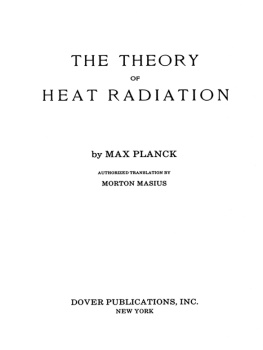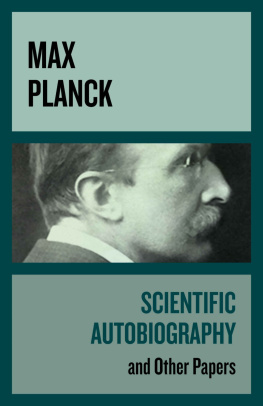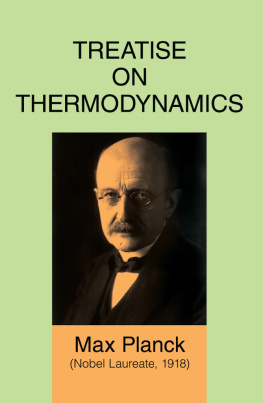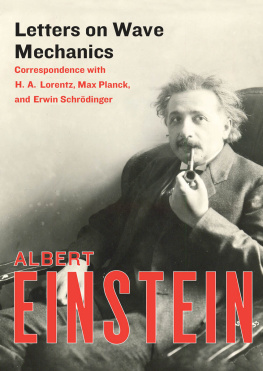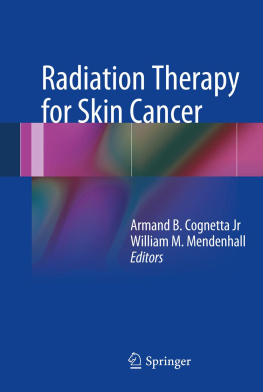Max Planck - The Theory of Heat Radiation
Here you can read online Max Planck - The Theory of Heat Radiation full text of the book (entire story) in english for free. Download pdf and epub, get meaning, cover and reviews about this ebook. year: 2012, publisher: INscribe Digital, genre: Romance novel. Description of the work, (preface) as well as reviews are available. Best literature library LitArk.com created for fans of good reading and offers a wide selection of genres:
Romance novel
Science fiction
Adventure
Detective
Science
History
Home and family
Prose
Art
Politics
Computer
Non-fiction
Religion
Business
Children
Humor
Choose a favorite category and find really read worthwhile books. Enjoy immersion in the world of imagination, feel the emotions of the characters or learn something new for yourself, make an fascinating discovery.
- Book:The Theory of Heat Radiation
- Author:
- Publisher:INscribe Digital
- Genre:
- Year:2012
- Rating:3 / 5
- Favourites:Add to favourites
- Your mark:
- 60
- 1
- 2
- 3
- 4
- 5
The Theory of Heat Radiation: summary, description and annotation
We offer to read an annotation, description, summary or preface (depends on what the author of the book "The Theory of Heat Radiation" wrote himself). If you haven't found the necessary information about the book — write in the comments, we will try to find it.
The Theory of Heat Radiation — read online for free the complete book (whole text) full work
Below is the text of the book, divided by pages. System saving the place of the last page read, allows you to conveniently read the book "The Theory of Heat Radiation" online for free, without having to search again every time where you left off. Put a bookmark, and you can go to the page where you finished reading at any time.
Font size:
Interval:
Bookmark:
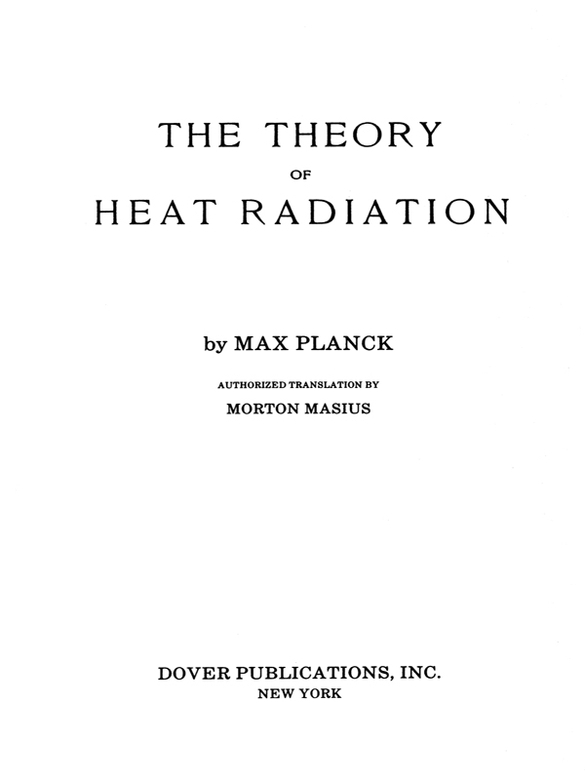
On Deductions from Stirlings Formula.
The formula is
(a)

or, to an approximation quite sufficient for all practical purposes, provided that n is larger than 7
(b)

For a proof of this relation and a discussion of its limits of accuracy a treatise on probability must be consulted.
On substitution in (170) this gives

On account of (165) this reduces at once to

Passing now to the logarithmic expression we get

or,

Now, for a large value of N i, the term N i log N i is very much larger than log  , as is seen by writing the latter in the form
, as is seen by writing the latter in the form  log 2 +
log 2 +  log N i. Hence the last expression will, with a fair approximation, reduce to
log N i. Hence the last expression will, with a fair approximation, reduce to
S = k log W = k [ N log N N 1log N 1 N 2 log N 2 ..... ].
Introducing now the values of the densities of distribution by means of the relation
N i = i N
we obtain
S = k log W = kN [log N i log N 12 log N 2 ... ],
or, since
1+2+3+... =1,
and hence
(1+2+3+... ) log N = log N ,
and

we obtain by substitution, after one or two simple transformations
S = k log W = kN  1 log 1,
1 log 1,
a relation which is identical with (173).
The statements of Sec. 143 may be proven in a similar manner. From (232) we get at once

Now
log ( N 1)! = log N! log N ,
and, for large values of N, log N is negligible compared with log N! Applying the same reasoning to the numerator we may without appreciable error write

Substituting now for ( N + P )!, N !, and P ! their values from (b) and omitting, as was previously shown to be approximately correct, the terms arising from the  etc ., we get, since the terms containing e cancel out
etc ., we get, since the terms containing e cancel out

This is the relation of Sec. 143.
Among general papers treating of the application of the theory of quanta to different parts of physics are:
1. A . Sommerfeld, Das Plancksche Wirkungsquantum und seine allgemeine Bedeutung fr die Molekularphysik, Phys. Zeitschr., , p. 1057. Report to the Versammlung Deutscher Naturforscher und Aerzte. Deals especially with applications to the theory of specific heats and to the photoelectric effect. Numerous references are quoted.
2. Meeting of the British Association, Sept., 1913. See Nature, , p. 305, Nov. 6, 1913, and Phys. Zeitschr., , p. 1297. Among the principal speakers were J. H. Jeans and H. A. Lorentz. (Also American Phys. Soc., Chicago Meeting, 1913.)
3 . R. A. Millikan, Atomic Theories of Radiation, Science, , p. 119, Jan. 24, 1913. A non-mathematical discussion.
4. W. Wien, Neuere Probleme der Theoretischen Physik, 1913. (Wiens Columbia Lectures, in German.) This is perhaps the most complete review of the entire theory of quanta.
H. A. Lorentz, Alte und Neue Probleme der Physik, Phys. Zeitschr., , p. 1234. Address to the Versammlung Deutscher Naturforscher und Aerzte, Knigsberg, 1910, contains also some discussion of the theory of quanta.
Among the papers on radiation are:
E. Bauer, Sur la thorie du rayonnement, Comptes Rendus, , p. 1466. Adheres to the quantum theory in the original form, namely, that emission and absorption both take place in a discontinuous manner.
E. Buckingham, Calculation of c2 in Plancks equation, Bull. Bur. Stand. , p. 393.
E. Buckingham, On Wiens Displacement Law, Bull. Bur. Stand. , p. 543. Contains a very simple and clear proof of the displacement law.
P. Ehrenfest, Strahlungshypothesen, Ann. d. Phys., , p. 91.
A. Joff, Theorie der Strahlung, Ann. d. Phys., , p. 534.
Discussions of the method of derivation of the radiation formula are given in many papers on the subject. In addition to those quoted elsewhere may be mentioned:
C. Benedicks, Ueber die Herleitung von Plancks Energieverteilungsgesetz, Ann. d. Phys., , p. 133. Derives Plancks law without the help of the quantum theory. The law of equipartition of energy is avoided by the assumption that solids are not always monatomic, but that, with decreasing temperature, the atoms form atomic complexes, thus changing the number of degrees of freedom. The equipartition principle applies only to the free atoms.
P. Debye, Plancks Strahlungsformel, Ann. d. Phys., , p. 1427. This method is fully discussed by Wien (see 4, above). It somewhat resembles Jeans method (Sec. 169) since it avoids all reference to resonators of any particular kind and merely establishes the most probable energy distribution. It differs, however, from Jeans method by the assumption of discrete energy quanta h . The physical nature of these units is not discussed at all and it is also left undecided whether it is a property of matter or of the ether or perhaps a property of the energy exchange between matter and the ether that causes their existence. (Compare also some remarks of Lorentz in .)
P. Frank, Zur Ableitung der Planckschen Strahlungsformel, Phys. Zeitschr., , p. 506.
L. Natanson, Statistische Theorie der Strahlung, Phys. Zeitschr., , p. 659.
W. Nernst, Zur Theorie der Specifischen Wrme und ber die Anwendung, der Lehre von den Energiequanten auf Physikalischchemische Fragen berhaupt, Zeitschr. f. Elektochemie, , p. 265.
The experimental facts on which the recent theories of specific heat (quantum theories) rely, were discovered by W. Nernst and his fellow workers. The results are published in a large number of papers that have appeared in different periodicals. See, e.g., W. Nernst, Der Energieinhalt fester Substanzen, Ann. d. Phys., , p. 395, where also numerous other papers are quoted. (See also references given in 1.) These experimental facts give very strong support to the heat theorem of Nernst (Sec. 120), according to which the entropy approaches a definite limit (perhaps the value zero, see Plancks Thermodynamics, 3. ed., sec. , et seq.) at the absolute zero of temperature, and which is consistent with the quantum theory. This work is in close connection with the recent attempts to develop an equation of state applicable to the solid state of matter. In addition to the papers by Nernst and his school there may be mentioned:
Font size:
Interval:
Bookmark:
Similar books «The Theory of Heat Radiation»
Look at similar books to The Theory of Heat Radiation. We have selected literature similar in name and meaning in the hope of providing readers with more options to find new, interesting, not yet read works.
Discussion, reviews of the book The Theory of Heat Radiation and just readers' own opinions. Leave your comments, write what you think about the work, its meaning or the main characters. Specify what exactly you liked and what you didn't like, and why you think so.

